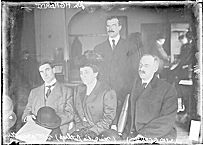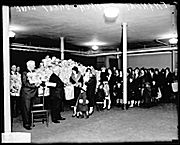| Entries |
| R |
|
Relief and Subsistence Aid
|

|
After the Civil War, relief in Chicago shifted subtly from an approach informed by a religious ethic of duty to one that sought to use relief to reduce the numbers of the poor. Initially, in the years between 1870 and 1890, this new method of charity was based on the perception of the poor as a problem of “pauperism,” which held that being poor was the product of moral lapses rather than a fact of social life. The Chicago Relief and Aid Society (CRA), understanding impoverishment in moral terms, restricted charity in order to teach lessons in proper living. The CRA thus distributed relief through bureaucratized methods in the hope that their approach would reduce the need for relief over the long term by forcing Chicago's poor to adopt self-reliant modes of conduct. After the crisis of the fire of 1871, the CRA attempted to gain citywide control of relief by trying to bring Chicago's charities under its purview. This effort met with little success, however, because charitable organizations wanted to retain control over their resources. The CRA's approach to relief supplanted neither religious charitable organizations nor the poor laws. Yet, its existence signaled that a new approach to relief would be part of relief for decades, one that sought to alter the character and circumstances of the poor rather than simply to meet their basic needs.

|
Although important figures in relief for a generation, women were increasingly finding productive careers in social services by this time. Again, despite new methods of relief, religious-based charitable organizations still provided relief out of moral obligation, though they too were centralizing their services. The Salvation Army, an important and fundamentally evangelical Christian organization, distributed relief based on the religious ideal that the poor will always exist and will need humane care. Although Progressive reforms did not eliminate the existence of older charitable institutions, they formed a new approach to relief, one that stressed the elimination of the conditions that caused poverty.
The economic crisis of the Great Depression forced an alteration in methods of relief, one which shifted responsibility to higher levels of government and which resulted in the development of social service administrative bureaucracies. The Depression spurred the development of the concept of welfare, which legitimated a guaranteed level of subsistence, and hastened the creation of governmental mechanisms to ensure that right. Though governmental organizations increasingly assumed control of charitable resources, local charitable organizations did not disappear. To the contrary, the U.S. welfare state worked in partnership with local public and private organizations to deliver resources to the needy. Religious organizations, for instance, remain crucial providers of food and shelter to those who have fallen through the social safety net, though they now work ecumenically and with Chicago's Human Services department or with associations like the Chicago Coalition for the Homeless. The Personal Responsibility Act (1996) substituted state-level responsibility for federal welfare and made relief contingent upon productive labor rather than right of citizenship.
Relief and subsistence aid has depended upon the way in which Chicagoans have defined the problem of the poor. Since there never has been one, unitary way of understanding the problem, there has never been one mode of relief. Yet trends in relief are discernable. What began as a moral responsibility dictated by religious belief has become an aspect of the broader society's quest to eliminate poverty.
The Encyclopedia of Chicago © 2004 The Newberry Library. All Rights Reserved. Portions are copyrighted by other institutions and individuals. Additional information on copyright and permissions.